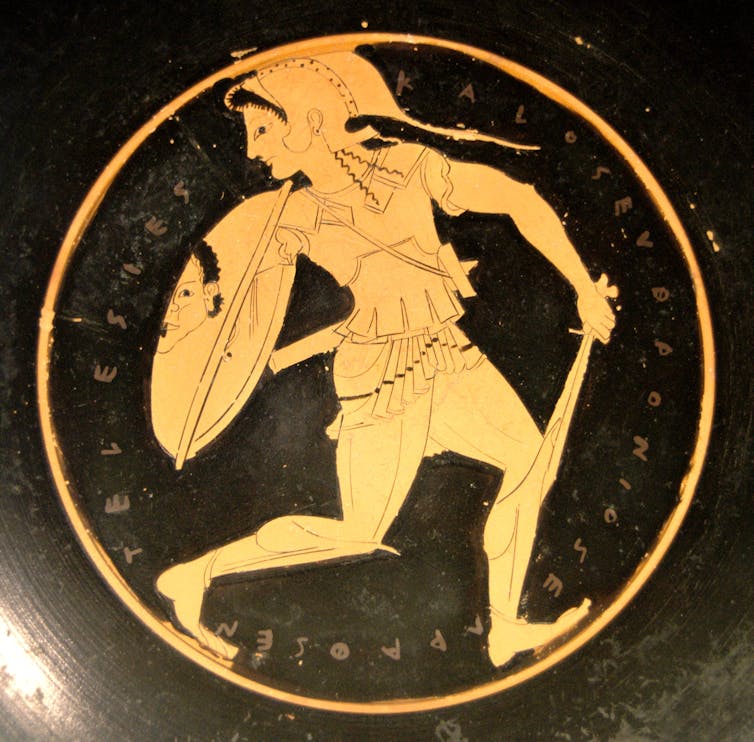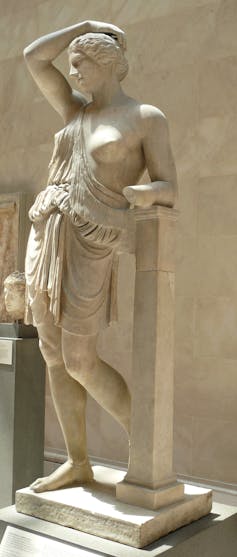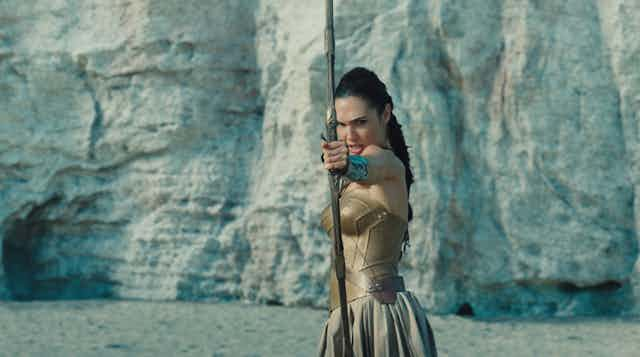The long-awaited film version of Wonder Woman opens this week, starring Gal Gadot as the indomitable superhero.
As Princess Diana of Themyscira, Wonder Woman is of Amazonian blue-blood. Formed from clay by her mother, Queen Hippolyta, and given life by the breath of Aphrodite, she is a demi-god. The gifts she receives from the gods of the Greek pantheon explain her superhero powers, which become evident when she transforms into Wonder Woman.
Wonder Woman made her debut in 1941 in All Star Comics. Her creator, American writer and psychologist William Moulton Marston, drew on a cornucopia of Greek mythology, blending stories from sources as diverse as the myths of Pandora, Odysseus, and Atalanta and the Amazons. Like all members of the Justice League team, Wonder Woman is an imaginative hybrid.

Marston’s comic draws heavily on the Amazon myths. Since the epics of the Homeric poets, there have been references to mysterious and frightening stories of the Amazons. In the Iliad, composed around the 8th Century BC, the Amazons were referred to as man-like, seasoned fighters. The implication is that in war they were a match for men in terms of their prowess, physical strength and courage. The Amazons appear in other Greek myths, such as the adventures of Heracles and Theseus.
Herodotus (484-c.425 BC) recorded detailed information, possibly spurious, but nevertheless fascinating, about this tribe of women. In his account, the Amazons were presented as horse riders, skilled with the bow and arrow, deft with the spear and ignorant of “traditional” women’s work. They were from Scythia (Ukraine, southern Russia and western Kazakhstan), a region sufficiently distant to an ancient Greek to symbolise a frightening, exotic and unknowable land populated by wild and threatening people. Herodotus also claimed that the Amazons had a marriage custom that forbade a young woman to marry until she had killed a man in battle.

The Greek geographer Strabo (64 BC–AD 20) recorded the belief that the Amazons seared their right breasts to better use a bow and arrow or throw a spear. He also wrote that the Amazons were believed to live separately from men - travelling into neighbouring territories to mate - but keeping only girls to rear. While Strabo admitted much of this was likely fanciful, his account provides an insight into Greek fears and anxieties surrounding the Amazons. Indeed, they appear to have been regarded as the bogeywomen of antiquity.
Marston’s knowledge of Greek mythology was extensive, and his ability to incorporate it into a new form truly remarkable. His character, Queen Hippolyte references the authentic mythical leader of the Amazons. Her daughter, Diana is a reference to the Roman equivalent of the Greek Artemis, the goddess of hunting, the wilderness, and wild animals. Likewise, the place of Princess Diana’s birth, Themiscyra, is mentioned by both Herodotus and Strabo as Amazon territory.
As a true Amazonian, Princess Diana is trained in a range of skills in both combat and hunting by her aunt, Antiope. However, as a member of the Justice League, she is not associated with some of the more “unusual” attributes of the ancient Amazons such as breast searing.
Separating fact from fiction
So were the Amazons real?
In her scholarly analysis of the Amazons from “fact” to fiction, folklorist and historian, Adrienne Mayor argues:
overwhelming evidence now shows that the Amazon traditions of the Greeks and other ancient societies derived in part from historical facts.

Mayor cites the Scythians as the most likely source of the Amazon legend. Nomadic peoples originally from Iran who migrated to southern Russia and Ukraine around the 8th Century BC, Scythian women were renowned for their horse riding and hunting skills, and participation in warfare. Along the steppes of Eurasia, archaeologists have excavated Scythian kurgans or burial mounds containing the skeletons of battle-scarred Scythian women along with collections of weapons, hunting equipment and tools.
These Scythian women clearly deviated in part from some of the mythical attributes of the Amazons. They did not, for example, live in all-female communities or remove their breast(s) to better shoot an arrow.
However, their very existence thousands of years ago not only suggests an inspiration for the myth of the Amazons, but also demonstrates how myths, legends and fairy tales work. Namely, the seemingly wondrous and often outrageous aspects of such narratives sometimes contain a kernel – or more than a kernel – of a truth that is then elaborated, altered and sensationalised to become an exciting, rollicking tale.
There are other aspects of Greek mythology in Marston’s Wonder Woman comic. For instance, he uses the basic plotline from Homer’s Odyssey to explain Princess Diana’s metamorphosis into Wonder Woman. On her isolated place of birth, Paradise Island, a Captain Steve Trevor falls from the sky when his plane crashes. This simple story echoes the travels of the ancient Greek hero Odysseus, who is washed ashore onto unknown islands on his way home from the Trojan War and rescued by beautiful women.

Diana falls in love with Trevor. Her mother, displeased, holds a competition to determine the worthiest Amazon to help him return to the world of man. Hippolyta forbids Diana from entering it. But she does – wearing a disguise – and wins. This bride competition lies at the heart of the mythical story of Atalanta, whose father arranges running races between his swift-footed daughter and her suitors, offering her as a prize for the man who can outrun her. As Trevor’s protector in his return to his own world, Princess Diana becomes Wonder Woman – aka Diana Prince.
But it is Marston’s use of the myth of the Amazons that may appeal most to our modern sensibilities. In an interview with the New Yorker, Mayor has described the Scythians as “a people notorious for strong, free women”. This image of independent, strong women certainly appealed to Marston, and his heroine is regularly cited as a feminist icon.
There are numerous exotic accounts of Amazons from antiquity through to the modern age. There are references to ancient nomadic cultures smoking cannabis, sporting tattoos, consuming alcohol and living outside the established boundaries of Greek morality. Some of these details come from ancient sources and some from modern archaeological excavations. It is now up to scholars to continue to make the connections and to separate fact from fiction.

